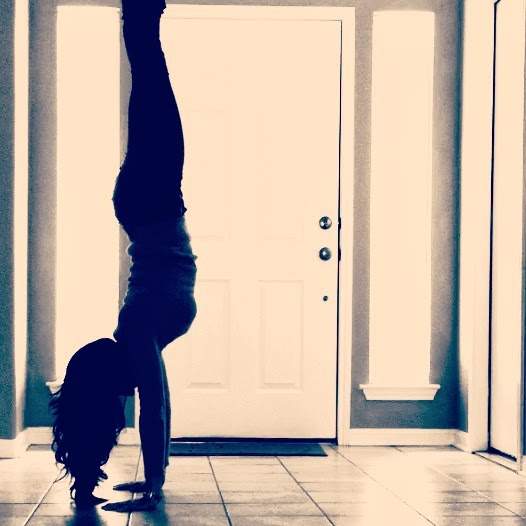Adho Mukha Vrksasana
Thanks to Instagram I am totally obsessed with
being able to do a handstand in the middle of the room. These people are
amazing. It's like gravity just doesn't affect them. I have done a handstand
pretty much every day since @carsonclaycalhoun hosted #handstandmadness back in March. And guess what? I still
can't handstand in the middle of the room. But I keep trying.
I just went to an Inversion workshop
with the amazing Kathryn Budig a few weekends ago in Austin. She had a lot of really helpful
tips. I keep hearing her voice in my head as I practice. It was scary and fun
and I'm very glad I went. If you are interested in doing handstands, I strongly
suggest you go to a workshop. You wont get very deep inversion help, or ample
time to practice going upside down, in a typical 60-minute flow class. You
have to take the extra time if you want to do something extra ordinary.
So maybe I still can't handstand
without a wall to help me from toppling over into a backbend. But I have
learned a thing or two in my journey. Here is what little I do know about
getting upside down:
It's fun.
It's like an addiction. The more I do
it, the more I want to do it. I will seriously be sitting watching TV and have
this strong urge to kick up into a handstand. I have been talking to friends
and felt like I wanted to just be upside down. It's weird. My brain says
"A handstand would be fun right now...do one."
To play with handstands, you have to
let go of fear. What are you afraid of? Falling? Well, you
most definitely will
fall. But most likely, it won't hurt at all. Just be smart. Don't do it over
jagged rocks or near a glass coffee table with lit candles. Yes, girl twerking
upside on YouTube, I'm talking to you.
Start facing a wall, in downdog, with
heels to the baseboards. Experiment with picking up one leg and pressing it
into the wall. Then lift the other leg and press both feet firmly into the
wall. There. That's a handstand.
It's made me stronger.
Handstands will strengthen your
shoulders, arms and wrists. They will tone your core by working the whole torso.
While balancing on your hands upside down, you are constantly stabilizing your
muscles and working the hell out of your abs and back.
I have started working handstand
practice into my gym routine. I was totally nervous at first. I can't handstand
without balancing against a wall, so I felt silly doing it at the gym with all
of these people watching me, and seeing that I can't really handstand. But one
day I found a relatively quiet corner and practiced. After doing some shoulder
press or lateral flies or core work, it feels really great to get into a
handstand. The muscles you need to turn on for handstands are already turned on
after some weight training. It's a great way to really feel which muscles
are being used. Sometimes I practice balancing, and kick right back up into
handstand the moment I fall out of it. And other times I lean my whole body
against the wall, taking balance out completely, and just hold it as long as I
can, seriously fatiguing my muscles.
It'll wake you up and make you happy.
Getting upside down will send lots of
freshly oxygenated blood to your brain and will give your brain a boost.
And the
intensity of the strength needed to hold a handstand gets your heart pumping
and increases energy.
Handstands can also make you feel
happier by reducing the stress hormone, cortisol. When the blood rushes through
your neck and into your brain, your endocrine system gets stimulated. The endocrine system
is made out of glands and each one of these glands secretes different hormones
into your bloodstream. When the adrenal glands are working, the production
of the cortisol is reduced.
It's cool as hell.
They look so damn cool.
Look, don't I look cool?









